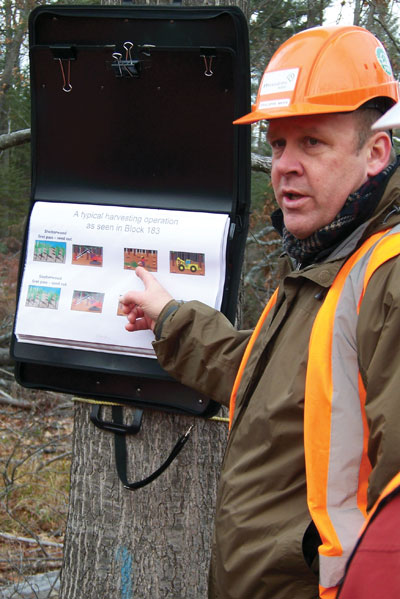
Biomass to Burn, but No Markets
February 16, 2012
By
David Manly
In late November 2011, representatives from all aspects of the biomass industry met in North Bay for a conference held by the Biomass Innovation Centre through Nipissing University.
In late November 2011, representatives from all aspects of the biomass industry met in North Bay for a conference held by the Biomass Innovation Centre through Nipissing University.
 |
|
| Philippe Meek from FPInnovations explained how harvesting biomass, saw logs and pulp was found to cost $3 less than simply harvesting logs and pulp. Photo: Andrea Ellis Nsiah
|
The conference, entitled Harnessing Biomass II: Support for Northern Ontario Bioeconomy Initiatives, was a two-day event, comprising six different sessions focused on aspects of biomass and its management. Each session included five or six different talks given by an expert in the field. Highlights included talks on forestry development and funding descriptions of handling/processing equipment and a variety of case studies.
The first presenter of the conference, Warren Mabee of Queen’s University, set the tone when he spoke about the issues and opportunities involved in harnessing and increasing Ontario’s bioeconomy. The greatest challenge, highlighted by Mabee and repeated numerous times throughout that day, was that the biomass potential for Northern Ontario is massive. However, the issues do not lie with obtaining a biomass supply or its harvest, but with its processing and transportation.
According to Mabee, there are no big biomass projects because the money for each kilowatt-hour of electricity generated is not enough to cover the cost of their supply, construction and transportation. In order to make such a large-scale operation viable, the feed-in-tariff (FIT) rates used would have to almost double.
But, said Mabee, trends suggest that the FIT rates are going down, not up.
Numerous experts throughout the conference, including the Canadian Institute of Forestry’s John Pineau, Indrajit Majumdar from the Ministry of Natural Resources and Denis Cormier from FPInnovations, discussed the biomass situation in Ontario at length. But no consensus was reached.
The clearest demonstration that Ontario has biomass to burn but nowhere to put it occurred during the first afternoon, at field trip taken to an experimental Tembec harvesting operation, where large mounds of biomass had been sitting for months.
The experimental harvesting operation, Tembec Block 183, lies within the Nipissing forest and consists of a series of treatment plots where employees and loggers harvest wood to produce pulpwood, saw logs and biomass, and explore the different methods used to sustainably harvest them.
The biomass, as part of the experimental project, was harvested to see which was more cost-effective: tree length operations (where trees are topped and de-limbed in the forest, while only the stem is brought to the landing for processing into saw logs and pulp) or full tree harvesting (where full trees, limbs and all, are moved to the landing then de-limbed and slashed to produce saw logs, pulp and biomass).
According to Al Stinson, a representative from the Ministry of Natural Resources, the results surprised everyone. They found that by topping in the landing and producing biomass in addition to logs and pulp, the process was $3 less than the standard harvesting method.
But, what can be done with the biomass?
“For $3 cheaper, you are getting three products instead of two,” said Stinson. “But the problem is, the biomass is here, ready to be taken, but we just don’t have somewhere for it to go.”
The Biomass Innovation Centre (biomassinnovation.ca/) hosted the conference with support from the Canadian Ecology Centre Forestry Research Partnership, the Ontario Trillium Foundation and the NRC Industrial Research Assistance Program.
Print this page